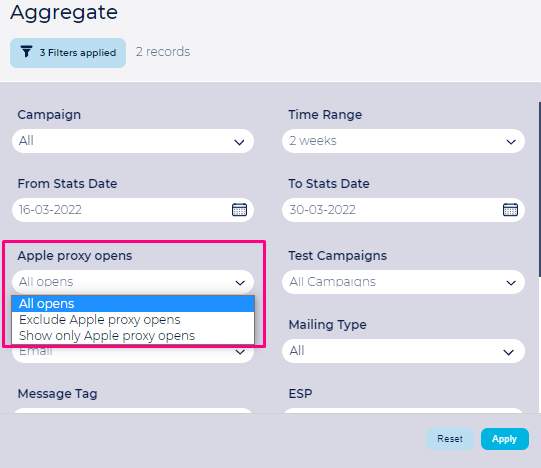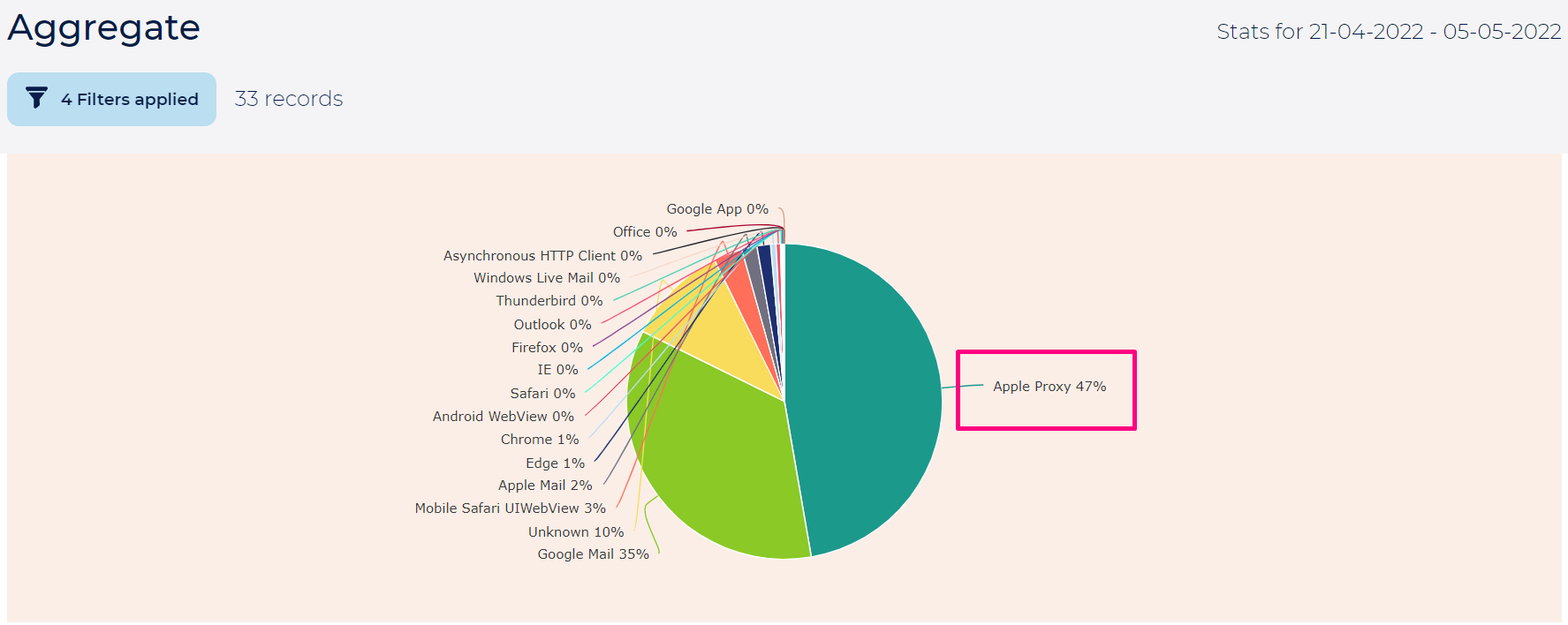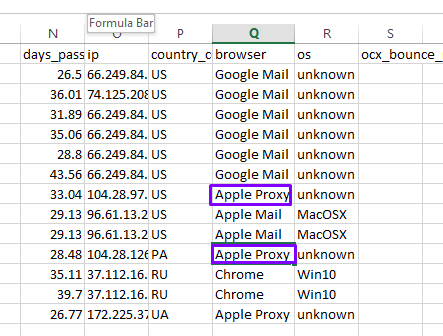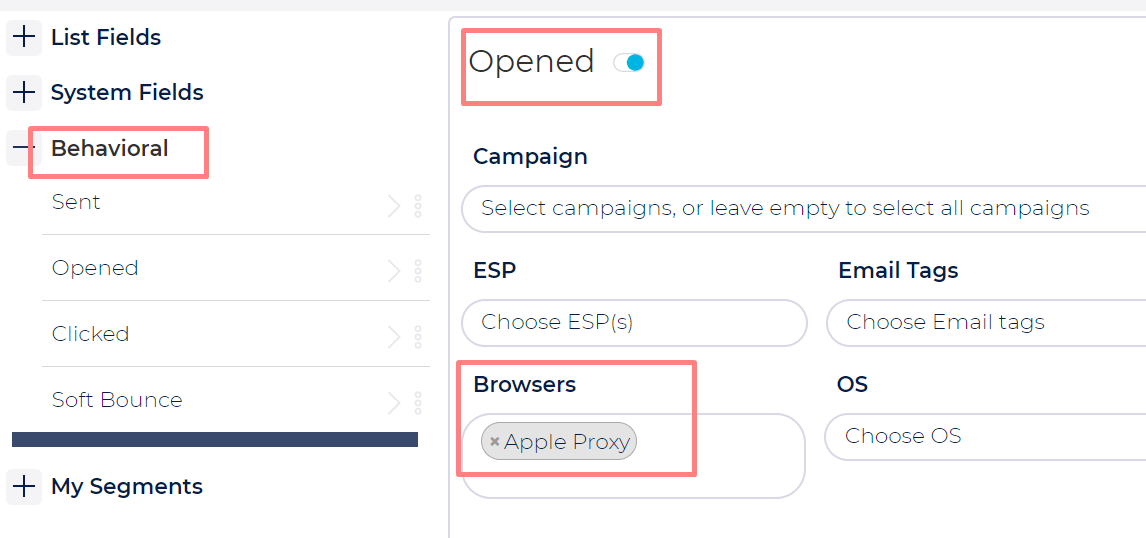Apple Mail Privacy Protection
Table of Contents:
Intro
![]() This article will be updated as more information regarding this change become available following the release of iOS 15 with MPP.
This article will be updated as more information regarding this change become available following the release of iOS 15 with MPP.
- This article is about Apple’s Mail Privacy Protection that was launched with iOS 15, in mid-late September 2021, and the possible effects it can have on your email operations in Ongage, along with information and suggestions on how to prepare and handle those changes within the Ongage platform.
- For detailed articles about this change in general in the email marketing world, see our Ongage Blog Posts:
- 22 Email Marketing Experts Explain How to Evolve With Apple’s Mail Privacy Protection (24/06/2021)
- Apple Mail Privacy Protection – Email Platforms Updates In 2022 (12/01/2022)
- See at the end of this page the 'Related Articles' section.
What Will Be Affected
As part of this change, Apple will pre-fetch the images in email message to a network of proxy servers.
This will have the following two key effects:
- It will hide the original IP of the recipient who opened the email message.
- The pre-fetching of the images will trigger some percent of opens, even if your end-recipient might not have actually opened the email message.
- We currently don't know what percent of Opens will be triggered. Our speculation is that there are a variety of factors at play, including location around the globe, and other factors to be seen. (See the 'Related Articles' section below with some reports about MPP adoption rates, and Proxy Opens rates).
Who Will Be Affected
This change only affects Apple iOS 15 and MacOS Monterey recipients, and only if:
- They are using the native Apple Mail App (i.e., not Gmail App for example on their iOS device).
- They upgraded to iOS 15 and MacOS Monterey.
- And only if they chose to enable Mail Privacy Protection in iOS 15 and MacOS Monterey.
![]() So depending on a wide variety of demographics variables, this change might have minimal to more significant effect on your email marketing operations.
So depending on a wide variety of demographics variables, this change might have minimal to more significant effect on your email marketing operations.
What Ongage Features Will Be Affected
Following are some of the key areas in Ongage that will be affected:
- Segments with open criteria and campaigns using those segments.
- Contacts who might not have actually opened an email, may fall into a recently opened criteria segment (only in the case of those noted above in 'Who Will Be Affected').
- Event & Triggers with segments using open criteria, as well as triggers based on an open of a previous trigger.
- Contacts who might not have actually opened in an event trigger will receive a follow-up message if based on an open.
- Automation Rules in particular ARs with transactional actions based on an open. Though other actions such as Webhooks based on an open will similarly be affected.
- One of the bigger concerns is regarding transactional actions, that might send out a large bulk of messages based on a open trigger, for opens triggered by the Apple proxy instead of actual user engagement.
- Per Country Open Stats in the Aggregate Report (for those who have this feature enabled in their account), then the IP to Geo mapping for iOS 15 opens might no longer be correct.
For any questions whatsoever regarding any matter on this page please contact Ongage Support.
Recommendations
Ongage Account Setting To Ignore Apple Proxy Opens
- On Sep-15-2021, just ahead of the release of iOS 15, Ongage released new Account Settings that enable Ongage Admins the flexibility to choose to ignore opens coming from Apple's proxy servers for the following Ongage features:
- Ignore Apple Mail proxy opens in Events & Triggers.
- Ignore Apple Mail proxy opens in Segments.
- Ignore Apple Mail proxy opens in Automation Rules.
- For more details about this new setting, see: Apple Mail Privacy Protection Settings in our Settings online help doc.
Important
- There is no way to distinguish between real user opens and fake opens triggered by the Apple proxy prefetch.
- The general recommendation is not to check the ignore proxy opens for Segments, BUT that depends on how you target openers, and the % of apple proxy opens you're seeing in each of your lists. Moreover, when targeting Openers it is best to add downstream behavioral conditions (e.g., Opened AND logged into service in the past 30 days). In addition its generally recommend to switch to targeting clickers.
- For the other ignore settings – Events & Triggers, and Automation Rules, again it depends on your setup, and the % of Apple proxy opens – but there the general recommendation is to ignore Apple proxy opens, and/or better yet – setup triggers based on clicks instead of opens.
Proxy Opens Still Provide Positive Info
- Proxy opens can be a valuable signal that an email address is valid. Specifically, they indicate that the email address is linked to a powered-on Apple device, so almost certainly associated with a real human being.
- Having said that, as of right now, there's no way to distinguish between real user opens on Apple iOS 15 with MPP and fake opens triggered by the Apple proxy prefetch.
Analytics
General
- With the possibility that a certain percent of open stats will become less reliable, we recommend looking more closely at your Clicks, CTRs and uCTRs for monitoring engagement.
- Some marketers look at the combination of open rates and soft bounce rates to gauge deliverability. With some of the open rates becoming less reliable those marketers will want to focus primarily on just the SB rate.
- Some marketers look at open rates to gauge inbox placement. With some of the open rates becoming less reliable those marketers will want to focus on clicks, CTRs and uCTRs stats.
Ongage Analytics
- In October Ongage added additional filters to the Aggregate Report to filter in or out Apple Mail Proxy opens.
- For larger paying customers that have the Browser, Geo and OS tabs opened in their Aggregate Report, they don't need the filter above, as they can get the Apple Proxy Open Stats directly from the Per Browser tab.
- Larger paying customer can also find Apple Proxy indication on the per contact level, in the Contact Activity Report and you can also Segment by it as their accounts have access to Browser, Geo and OS analytics.
On Tracking Engagement
As opens become less reliable here are some ways to capture contact engagement using various Ongage features:
- Make more use of Ongage Click tracking (vs. Open tracking) in your Ongage segments, Events & Triggers, and Automation Rules. Clicks are not affected by this Apple MPP change.
- Update on Click: capture contact interest and initial intentions with this click feature. Similarly with Post-back links. More about both features you'll find in our List Settings page document.
- Use the URL parameters feature for automatically adding web-tracking parameters to all your URLs, and get post-click engagement insights on your landing pages. See our List Settings → General for more about that feature.
- Use a preference center to capture various interests and preferences of your contacts.
- Capture post click engagement data (aka downstream engagement data) from your website (or Apps), and feed it back to Ongage with daily imports (manual or API) or real-time API calls. And you can use those methods, for any user engagement data you collect from any of your digital assets, such as social media, CRM, etc.
- Track post-click conversions on your website with Ongage conversion points.
Related Articles
- MediaPost Jan-11-2022: Apple MPP now accounts for 40.6% of all email opens
- Apple Mail Privacy Protection’s market share jumped by almost 57% from November to December 2021, and now accounts for 40.6% of all email opens, according to an update posted on Friday by Litmus.
- Apple Mail Privacy Protection’s market share jumped by almost 57% from November to December 2021, and now accounts for 40.6% of all email opens, according to an update posted on Friday by Litmus.
- MediaPost: Oct-06-2021: Apple Gets A Bite: MPP Receives A 20% Adoption Rate By Consumers To Date
- Apple Mail users have not opted in to Mail Privacy Protection (MPP) as quickly as doomsayers expected, judging by numbers provided by Validity. There was single-digit adoption during launch week starting on September 20. The number climbed to 10% last week, and this week it stands at 19.96% so far.
- Apple Mail users have not opted in to Mail Privacy Protection (MPP) as quickly as doomsayers expected, judging by numbers provided by Validity. There was single-digit adoption during launch week starting on September 20. The number climbed to 10% last week, and this week it stands at 19.96% so far.
- MediaPost: Oct-04-2021: Apple Delivers The Sauce: Content Is Being Prefetched On iOS 15
- Looking at the duration between each user's 'open' event and 'click' event it's possible to infer which type of open it was.
- Caching is occurring far closer to real-time than anticipated.
- MediaPost: Oct-1-2021: Mail Privacy Protection Kaboom! Apple Is Already Proxying 10% Of All Opens
- As of Sep-25-2021 10% of Opens are being prefetched.
- These opens are still a valuable signal that an email address is valid.
Appendix
Leading Up To The Launch of iOS 15
![]() This is an older entry from prior to the launch of iOS 15 and therefore moved to Appendix for now for archival purposes.
This is an older entry from prior to the launch of iOS 15 and therefore moved to Appendix for now for archival purposes.
As the effects of this change are not fully known till it will actually launch, we're recommending ahead of this change employing one of the following precautionary actions in the case of Automation Rules:
- Either disable your Transactional ARs based on an open trigger, till it becomes clearer how Apple MPP will affect them.
- Or switch your Transactional ARs to be based on clicks instead of opens.



